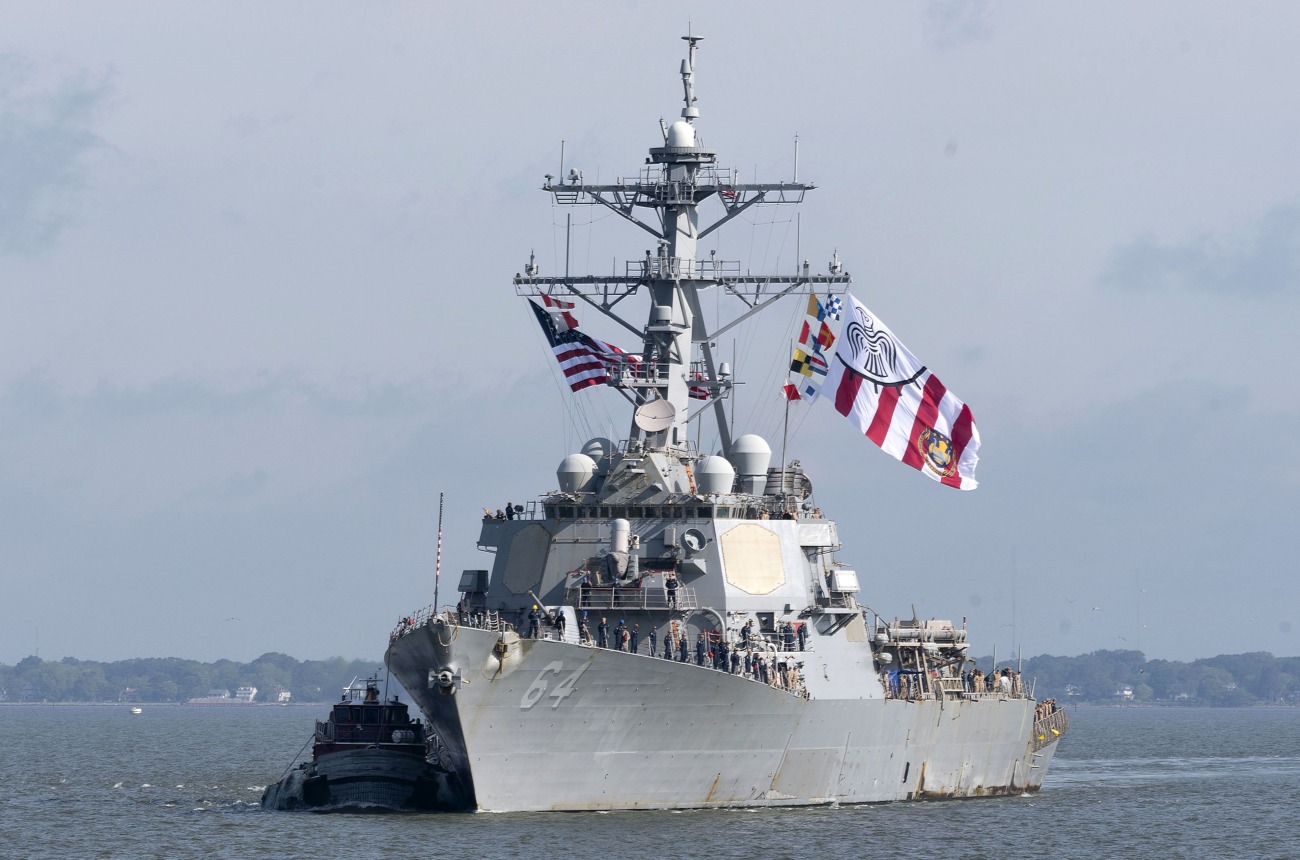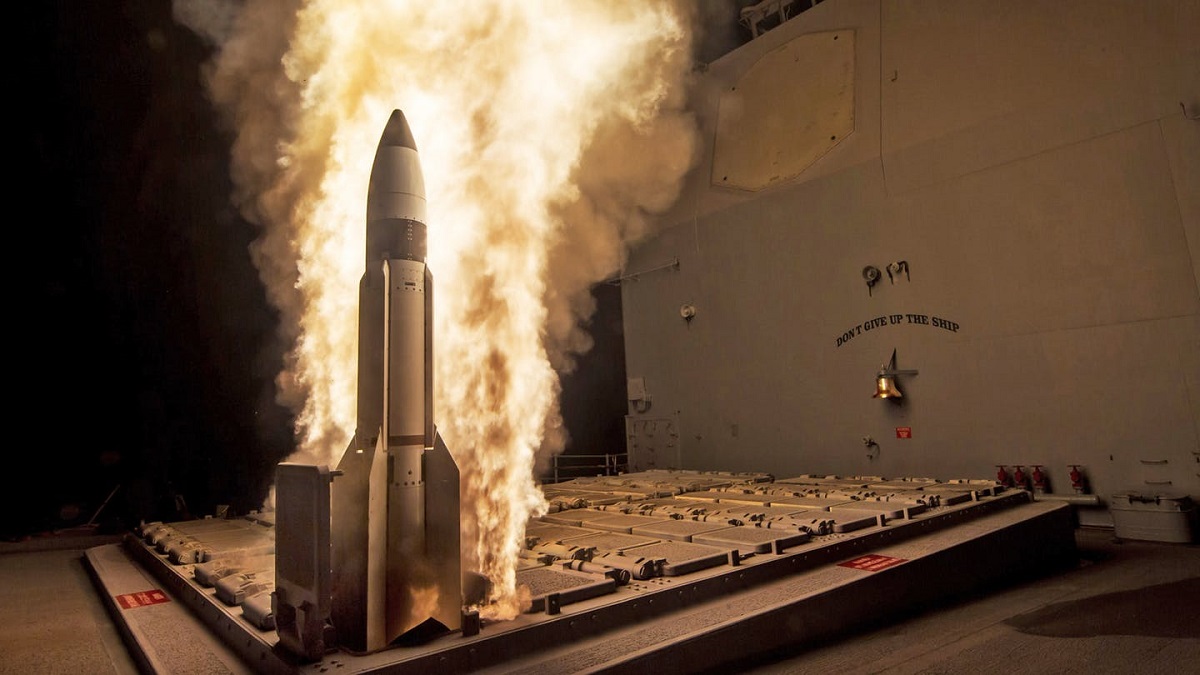After a historic seven-month deployment in the Middle East, the U.S. Navy’s Arleigh Burke-class guided-missile destroyer, USS Carney, has returned home as a hero and was awarded for its exceptional combat duty in the volatile Red Sea region.
The U.S. Navy’s official press statement announced that the Arleigh Burke-class guided-missile destroyer USS Carney (DDG 64) returned to Naval Station Mayport, Florida, on May 19 after being stationed in the U.S. Naval Forces Europe—Africa and U.S. Naval Forces Central Command areas of operation for more than seven months.
The press statement noted, “Carney deployed for 235 days to the Mediterranean Sea, Red Sea, Gulf of Aden, and Arabian Gulf, providing deterrence and defense to U.S. Allies and partners. Carney was the first ship in the area to intercept land-attack cruise missiles and unmanned aerial vehicles (UAV) launched by Houthi forces toward Israel in October 2023.”
USS Carney (DDG 64) was also bestowed with the honor of Navy Unit Commendation (NUC) by Secretary of the Navy Carlos Del Toro for “outstanding performance against terrorist forces during their nearly eight-month deployment.”
The NUC is the second-highest unit award in the Department of the Navy, after the Presidential Unit Citation, and is given to any ship, aircraft, or other unit of the Navy or Marine Corps that has distinguished itself by exceptional heroism in battle against enemy forces.
Welcome home USS Carney! 🥳🎉🙌🎊
The guided-missile destroyer returned to @NS_Mayport today after a seven-month deployment, where it was the first ship to intercept land-attack cruise missiles and unmanned aerial vehicles launched by Houthi forces toward Israel in October 2023. pic.twitter.com/pGLLdbkRxz
— U.S. Fleet Forces (@USFleetForces) May 19, 2024
“Carney was deployed forward, deterring our adversaries, protecting our national interests, defending the rules-based international order, and promoting peace,” said Secretary Del Toro. “I, and all Americans, am immensely proud of these Carney Sailors. They represent the best of the Department of the Navy and indeed our Nation.”
The United States dispatched the destroyer to the region after the October 7 attack on Israel by Hamas. The initial goal for dispatching the vessel along with other resources was to prevent a region-wide escalation, as Israel launched an unprecedented bombing campaign against Gaza. Several regional militias, including the Yemen-based Houthis, have carried out multiple attacks on Western military and commercial vessels in the region in the last six months.
According to the Navy, the USS Carney participated in the Red Sea operations along with the Gerald R. Ford and Dwight D. Eisenhower Carrier Strike Groups, protecting commercial shipping lanes, merchant mariners, and American, allied, and partner vessels from drone and missile attacks carried out by the Houthis.
Although it was independently deployed, Carney collaborated closely with allies and partners on a range of duties while serving as an air defense unit protecting strike group forces in the Red Sea and the eastern Mediterranean.
While welcoming the ship back earlier this month, Chief of Naval Operations Adm. Lisa Franchetti said, “The last time our Navy directly engaged the enemy to the degree that you have was way back in World War II, and it was the USS Hugh Hadley (DD-774), with her engagement record of 23. You saved lives, ensured the free flow of commerce, and stood up for the rules-based international order and all the values that we hold dear. It has been eye-watering to watch, you are truly America’s Warfighting Navy in action.”
USS Carney’s Spectacular Combat In The Middle East
The ship was deployed to the Middle East when the Houthis started firing ballistic and cruise missiles, as well as airborne and underwater drones, against military and commercial vessels in the Red Sea, Bab al-Mandab, Gulf of Aden, and Israel.

The Houthis, for one, started their operations following the Israeli Defense Forces’ catastrophic ground assault and a large-scale bombing campaign, which has come to be classified as a genocide by several states across the world.
The Navy reports that during Carney’s crew’s roughly six-month deployment in the Red Sea region, they destroyed sixty-five Houthi targets that were launched from Yemen and on the ground there.
Adm. Lisa Franchett stated that the ship had “51 engagements” with the Houthis.
According to a Navy release, Carney also “successfully destroyed 45 Houthi-launched weapons, including unmanned systems, land attack cruise missiles, and anti-ship ballistic missiles.” Moreover, the ship “destroyed 20 targets in two defensive strikes against Houthi targets in Yemen.” What transpired in the six battles against targets launched by the Houthi that did not end in destruction is unknown.
Additionally, Carney created history last month by being one of only two Navy vessels to use Standard Missile-3 (SM-3) anti-ballistic missile interceptors in action for the first time.
The massive Iranian missile and drone bombardment against Israel on April 14 was the first time the SM-3s, while being in the Navy’s arsenal for years, were employed against real threats.

According to reports, in January this year, the Carney was also the first warship in the Gulf of Aden to fire a U.S. Navy SM-6 missile against a Houthi anti-ship ballistic missile.
As outlined in the NUC, Carney “protected vital global commerce through two strategic maritime chokepoints, defended key allies and partners, deterred aggression, and forged partnerships founded on trust and unity of effort against violations of international law. In self-defense, they destroyed many unmanned aerial vehicles, anti-ship ballistic and cruise missiles, land attack cruise missiles, and small boats, and they provided a crucial naval presence in the region at a pivotal moment in history.
- Contact the author at sakshi.tiwari9555 (at) gmail.com
- Follow EurAsian Times on Google News




